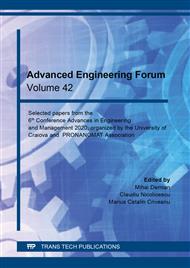p.113
p.122
p.128
p.137
p.143
p.151
p.159
p.167
p.176
Characteristics of Wastewater from Different Pretreatments of Flax/Cotton Fabrics
Abstract:
To be properly used in the textile industry, the natural materials are subject to different pretreatments. During the scouring, the non-cellulosic attendants (wax, pectin, pigments) are removed. The enzymes have proved their efficiency in this regard but also in terms of being friendly with the environment. The textile industry is a water large consumer, comprising many wet processes: bioscouring, bleaching, mercerizing, and dyeing. The water quantity needed for each step is very high. The resulted wastewater comprises different types of chemicals, most of them non-biodegradable: acids, sodium hydroxide, hypochlorites, peroxides, etc. The actual trends and legislation require the change of classical methods used with ecological ones. One particular reason for this tendency is also related to the economic issue, the use of eco-friendly treatments leading to significant economical savings. The present study was focused on enzymatic treatments with the use of two chelating agents (sodium citrate and EDTA) to remove the flax/cotton fabric impurities. The new proposed scouring treatment, with sodium citrate as a chelating agent, presents less aggressivity to the environment compared with the classical one. The temperature used was lower (55 °C), the pH close to the neutral point, and biodegradable chemicals were used. The chosen technology included a series of independent steps which they assumed: washing of flax/cotton fabric at 100 °C for dust and physically linked impurities removing, dried at room temperature, and conditioning at 105 °C in the oven for 2h. Afterward, the samples were immersed in the reaction bath which contained a mixture of pectinolytic products, the chelating agents (sodium citrate or EDTA), and the surfactant. The hydrolytic reaction was optimised following the influence of a pair of parameters: enzyme concentration/exposure time. Water samples from each reaction bath were collected and different physicochemical parameters were analysed: pH, salinity, TDS, conductivity, DO, CCOMn, turbidity and dry residue. The results obtained were following the legislation. In the case of the classical treatment, the data was up to 100 % higher compared with the new proposed treatment were complexing agent sodium citrate was used. Analysing from different points of view the results obtained, we can say that the considered treatment could be a promising alternative to the current one. It might contribute to less wastewater pollution and technological economical improvement.
Info:
Periodical:
Pages:
143-150
Citation:
Online since:
September 2021
Authors:
Price:
Сopyright:
© 2021 Trans Tech Publications Ltd. All Rights Reserved
Share:
Citation:


